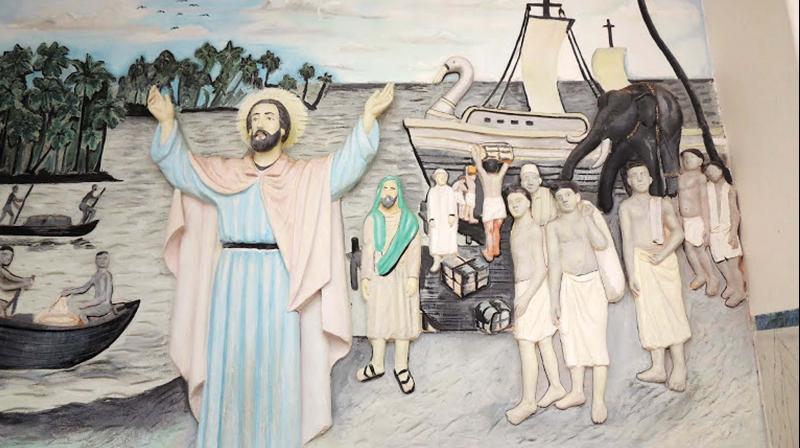St Thomas visited state: New book
Former Syro-Malabar Church spokesman Paul Thelakkat says there is not much credence to the claim on Brahmin conversions.

Kottayam: Claims and counter-claims about the visit of St Thomas apostle to Kerala in the first century AD continue unabated. Theologian Father Dr Xavier Koodapuzha, in an updated version of his book 'Bharatha Sabha Charithram,' has asserted that St Thomas visited the state, brushing aside the arguments raised against the belief by various scholars.
He has introduced ancient documents from the European, Syriac, Greek and Latin languages from early centuries to prove his claim, including the Malayalam translation of the Greek drama 'Charition' written supposedly in the first century which has references to St Thomas.
He told Deccan Chronicle that those who doubted the visit of St Thomas didn't have access to the documents in other languages.
He negates the arguments that Brahmins didn't exist in the first century AD saying that Jews, Dravidians and Brahmins were converted and not just Brahmins alone. Dr Koodapuzha, who was a professor of history and theology for over 35 years, is well versed in 12 languages, including Greek, Latin and Syriac. Koodapuzha quotes
‘Charition,’ a drama believed to have been authored between the first and second centuriesin which references to St Thomas were found. The setting of the drama is a coastal port town in Kerala.
‘Charition’ comprises 87 full dialogues in which 55 are in Greek and 32 in the Indian dialect.
D.L. Page, an Oxford University scholar in his ‘Select Papyri’(a study describing the original Papyrus manuscripts of the first century) maintains that ‘Charition’ was written either during the close of first century AD or the beginning of the second.
“The word ‘Thouma’ occurs twice in the drama which deals with the journey of a Greek woman in a ship with her brother to India. ‘Thouma’ is St Thomas which is evident from the context in the drama. Its major part is the St Thomas Christian worship of first century AD and St Thomas is mentioned twice during worship,” said Dr Zacharia Mani, who retired as Chief Commissioner of Income tax department, Karnataka and Goa in 2002. His research took 14 years to complete, he claims.
Dr Koodapuzha also quotes the works of St Aprem (306 – 378 AD), who mentions about the work of St Thomas in the Syriac language. “The big lantern which is part of the 12, immersed with the secretion from the Holy Cross, you fill the darkness of India by your light,” says one of the references quoted by Koodapuzha from the writings of St Aprem in Syriac. He also quotes from the works of St Gregory Nazianzen (324 – 390 AD) who mentions about St Thomas’s connection with India.
So also the works in Greek and Latin by St Ambros of Milan (333 – 397 AD) who mentions about St Thomas. “Those places divided by big mountains became their favourite places, and hence India for St Thomas. St Jerome (342 – 420 AD) in his work in Latin mentions about the export of pepper from Kodungalloor and also about St Thomas and India.”
Isidor Sevil ( 648AD), who was an earth scientist, in his work says about Indians. “St Thomas spoke gospel to the natives of Persia, Hercania, Mediya, Bactriya and India. St Thomas hallmarked the spread of his gospel by his martyrdom. He succumbed to the stab injuries at a city named Kalamina ( former name of Mylapore) and was buried at the place with respect.
A Portuguese traveller named Camoyans who visited India in 1553 went to Lisben in 1567. The book ‘Luciyads’ published by him in 1572 says that St Thomas while preaching gospel to the public was stabbed by a person with a dart.
Regarding the charges that there were no Brahmins at the time of the arrival of St Thomas, Dr Koodapuzha says that there were trade relations with Jews and groups of Jews, Dravidians and upper caste Hindus existed in the state and probably St Thomas converted them to Christianity.
Historian M.G.S. Narayanan who contends that St Thomas didn't visit the state said that there is no evidence to prove the visit of St Thomas to the state and that the claim of the conversion seems to be unreliable since it began only later. He however, said that ‘Charition’ belongs to the first century. Some reliable pieces of evidence such as copper plates needed to be discovered to establish the visit.
Historian Dr Rajan Gurukkal says that though there is no historical evidence of the visit of St. Thomas to Kerala, a strong tradition exists among the Syrian Christians. Nevertheless, the visit is quite a possibility since during the alleged period (first century common era), many Persians, Nestorians and Arabs were reaching the Kerala coast as overseas traders in spices and St. Thomas could have followed them.
“Tradition says that St. Thomas converted a few Brahmins first and built seven churches. These are later additions, for there were neither Brahmins in Kerala nor churches anywhere in the world as early as in 52 CE”, Dr Gurukkal added.
Former spokesperson of the Syro-Malabar Church, Father Paul Thelakkat, said that according to historians and the available records, the claim that St Thomas converted Brahmins will not stand. “Since the Brahmins came to South India only in the sixth century, the claim that St Thomas converted Brahmins may not stand as the apostle came to the state in the first century AD. However, I will not contest that St Thomas visited the state,” Father Paul told DC.
Dr Geevarghese Mar Koorilose, Bishop of the Niranam diocese of the Jacobite Syrian Church, also said that he was only contesting the theory that Brahmins were converted by St Thomas to Christianity. He never questioned the visit of St Thomas.
